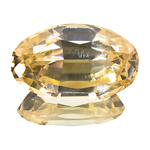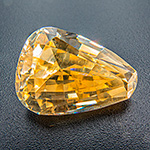Scheelite
Very common sulfate mineral.
Scheelite shop

Due to it's low hardness and distinct cleavage, Scheelite is only very rarely cut as a gemstone and not suitable for use in jewellery.
Origin of name: named in 1821 by German mineralogist Karl Caesar von Leonhardafter after the German-Swedish chemist and apothecary Carl Wilhelm Scheele.
Source: Wikipedia
Synonyms and trade names: none for gem Scheelite. Calcium tungstate in chemistry.
Can be confused with: due to the very high refractive index, which lies outside the range of standard refractometers, identification of cut and polished Scheelite can be tricky. The very high density (specific garvity) is no big help either, because there are a number of minerals with similar physical properties, such as Zircon, Cerussite, Anglesite, Powellite, Wulfenite and Cassiterite.
Localities: so far (2013) almost 4400 known occurrences. The largest crystals were found in Namibia, Japan, Korea and Malaysia.

Exceptionally fine scheelite from Natas Farm, near Gamsberg, Namibia
Handling: Scheelite is sensitive to acids and pressure, scratches easily and thus is unsuitable for jewellery use.
Worth knowing: Scheelite was first described in 1781 for an occurrence in Mount Bispbergs klack, Säter, Dalarna, Sweden. Owing to its unusual heaviness, it had been given the name tungsten by the Swedes, meaning “heavy stone".
Source: Wikipedia
Scheelite shop
 Deutsch
Deutsch